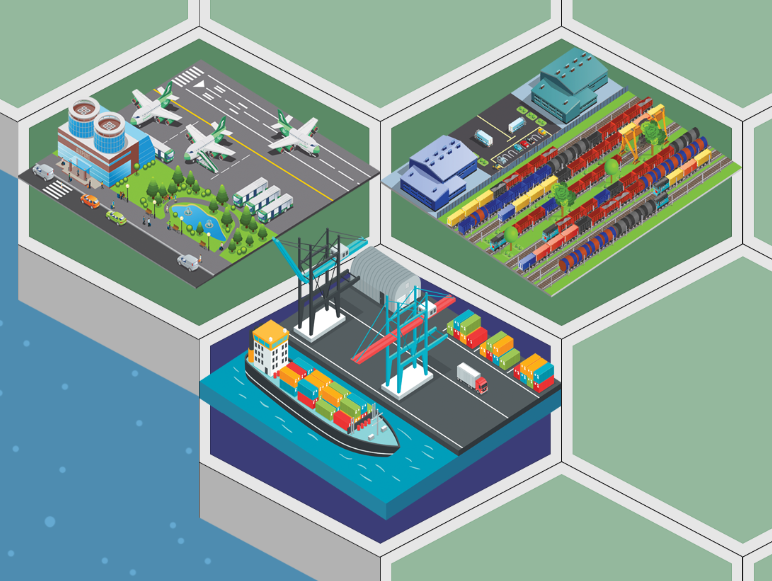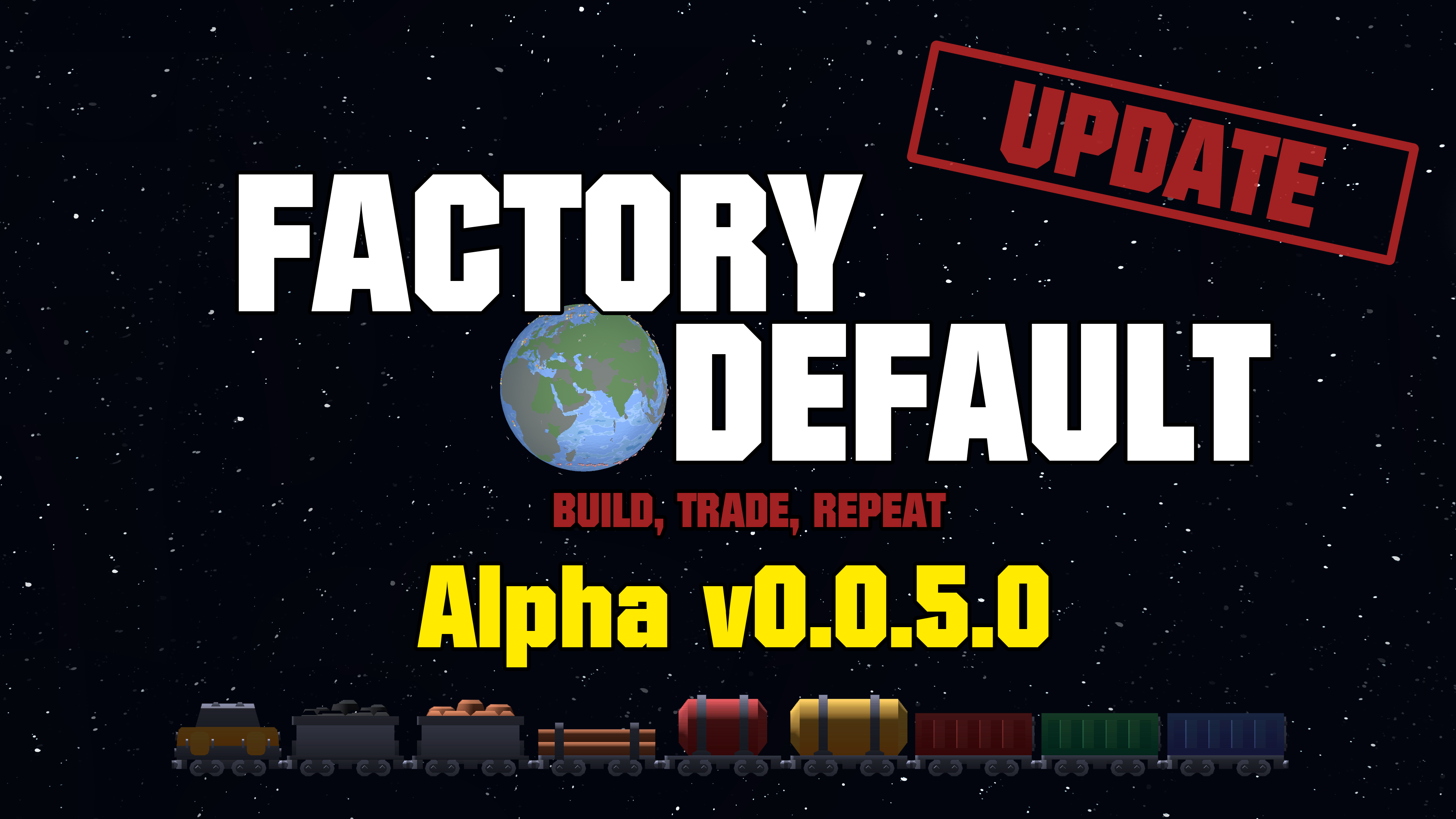Dev Diary 19 - Exports and Trade Vehicles
Beyond just producing and selling resources, it is just as important to transport them around the world. Trade prices from one country to another can vary, and the market can flux at any moment forcing you to change your strategy. That's where exports and transport vehicles come in. There are 3 different types of buildings that allow you to transport goods from one country to another.

Train Station, Seaport, and Airport. Trade buildings come with 100 tons of storage.
Train Stations are where you hire Cargo Trains.
Cargo Trains can transport up to:
-10,000 tons or 1,000,000 units of goods. -At a speed of 1,440 km/day. -Costing $10,000/day to charter.
Sea Ports are where you hire either Carrier Ships or Container Ships.
Carrier Ships can transport up to:
-200,000 tons or 20,000,000 units of raw goods. (Meaning anything that is mined or farmed.) -At a speed of 600 km/day -Costing $25,000/day to charter.
Container Ships can transport up to:
-20,000 tons or 2,000,000 units of goods. -At a speed of 840 km/day. -Costing $20,000/day to charter.
Airports are where you can hire Cargo Planes.
Cargo Airplanes can transport up to:
-200 tons or 20,000 units of goods.
-At a speed of 20,400 km/day. -Costing $50,000/day to charter.
In order to initiate an export, both the sending and receiving countries need to have the specified building type.
Example: If you want to send goods via an airplane from Brazil to Canada. Make sure both countries have an airport before you start trying to trade.
At level 1, each building can have up to 2 exports assigned to it. (With no limit to the number of imports.) Each level up will allow 2 more export slots.
When starting an export, you will first select the country you want to send to. At this point if you are in an Train Station or an Airport, it will tell you the Estimated Time of Arrival. How long it will take the transport vehicle to travel from where you are to the destination. If you are in a Seaport, you will have to select the good you are wanting to transport before it will give you the ETA. This is because depending on what type of good you select, you will use one type of ship or the other.
The other decision you will have to make is how often you want to send the good. Options are as follows:
- One Time
- Daily
- Every 2 Days
- Every 3 Days
- Every 4 Days
- Every 5 Days
- Every 6 Days
- Every Week
- Every 2 Weeks
- Every 3 Weeks
- Every 4 Weeks
- Wait for a Full Load
While that is a lot of options, there are really only two that I would recommend in 95% of cases. If you are just trying to get some goods to another country as a one time thing, you should obviously just select "One Time". The other option you should consider is "Wait for Full Load". This will tell the building every day. "Hey, can we fill a [transport_vehicle]?" if yes, send it out. If no, wait another day. This is handy because there is no wasting money on transporting empty vehicles or even 90% full vehicles. If you select the "Wait for Full Load" option, and your country doesn't have enough storage, the transport will never happen. It will tell you in the transport building if this is the case with a little red [!] after you save it.

It will also give you some estimated values based on a full load. The values are estimated because the values of all items change every day.
- Export Tax: This is simply the value of the goods multiplied by the export tax rate of the exporting country. This is paid the moment the export leaves the station/port.
- Travel Costs: This is the ETA multiplied by the daily rate. This is billed/paid daily. Chartering is expensive!
- Import Tax: This is the value of the goods multiplied by the import tax rate of the importing country. This is paid the moment the import enters the station/port.
- Destination Market Value: This is the trade value of the full load of goods at the destination.
- Profit: This is the Destination Market Value minus the costs and taxes. This does not take into account the money it cost to produce the good in the first place.
Something to note is that the act of importing and exporting happens behind the scenes. That is to say, an airplane arriving at a country is triggered by the world_tick_manager of the game and not the model of the airplane landing in its destination country. They can get slightly out of sync by a day or two. This is also important to know when you are loading a game. Just because the model of the trade isn't depicted, doesn't mean the trade didn't happen, it did. I just didn't feel that the locations and orientations of trade vehicles was worth saving and loading.
Something to also note. I took liberties with ocean and land connections so that most of the world was connected by land, and sea. There are just a hand full of countries that don't have one or the other. I wanted you to be able to send a train from Argentina to South Africa. So we're just pretending there is a bridge from Alaska to Russia.
That is all there is to it!
Upcoming:
-DD20: User Settings
-DD21: Private Shares
-DD22: Loans
-DD23: Public Shares
-DD24: ???
Files
Get Factory Default: Build, Trade, Repeat
Factory Default: Build, Trade, Repeat
Develop a worldwide conglomerate where you control the entire production chain.
| Status | In development |
| Author | SirChett |
| Genre | Simulation |
| Tags | Economy, factory, Farming, Idle, mining, refining, Singleplayer, supply-chain, Trading, workforce |
| Languages | English |
More posts
- Factory Default: BTR - v0.0.5.0 - A New Continent?6 days ago
- Factory Default: BTR - Patch v0.0.4.158 days ago
- Factory Default: BTR - Alpha v0.0.4.0 Update - AUCTIONS & BULLDOZERS!61 days ago
- Upcoming Bulldozer Production Chain74 days ago
- Progress - Auctions81 days ago
- Factory Default: BTR - Updated to v0.0.3.0 - Uranium Fuel Assemblies & More!Mar 23, 2025
- Progress - Research Tree WIPMar 04, 2025
- Factory Default: BTR - Updated to v0.0.2.0Mar 01, 2025
- Dev Diary 24 - Wrap UpFeb 17, 2025
- Dev Diary 23 - Public SharesFeb 16, 2025

Leave a comment
Log in with itch.io to leave a comment.